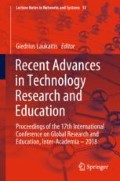Abstract
In this paper, we present a Cluster-Based Approach (CBA) that utilizes the support vector machine (SVM) and an artificial neural network (ANN) to estimate and predict the daily horizontal global solar radiation. In the proposed CBA-ANN-SVM approach, we first conduct clustering analysis and divided the global solar radiation data into clusters, according to the calendar months. Our approach aims at maximizing the homogeneity of data within the clusters, and the heterogeneity between the clusters. The proposed CBA-ANN-SVM approach is validated and the precision is compared with ANN and SVM techniques. The mean absolute percentage error (MAPE) for the proposed approach was reported lower than those of ANN and SVM.
Access this chapter
Tax calculation will be finalised at checkout
Purchases are for personal use only
References
Hernandez, R.: Environmental impacts of utility-scale solar energy. Renew. Sustain. Energy Rev. 29, 766–779 (2014)
Hosseini, E.: A review on green energy potentials in Iran. Renew. Sustain. Energy Rev. 27, 533–545 (2013)
Torabi, M., et al.: A Hybrid Clustering and Classification Technique for Forecasting Short-Term Energy Consumption, Environmental Progress & Sustainable Energy. Wiley, Hoboken (2018)
Mekhilef, S.: A review on solar energy use in industries. Renew. Sustain. Energy Rev. 15, 1777–1790 (2011)
Imani, M.H.: Strategic behavior of retailers for risk reduction and profit increment via distributed generators and demand response programs. Energies 11(6), 1–24 (2018)
Rusen, S.: Estimation of daily global solar irradiation by coupling ground measurements of bright sunshine hours to satellite imagery. Energy 58, 417–425 (2013)
Darvishzadeh, A.: Modeling the strain impact on refractive index and optical transmission rate. Physica B: Condens. Matter 543, 14–17 (2018)
Ulgen, K., Hepbasli, A.: Diffuse solar radiation estimation models for Turkey’s big cities. Energy Convers. Manag. 50, 149–156 (2009)
Karakoti, I., Pande, B., Pandey, K.: Evaluation of different diffuse radiation models for Indian stations. Renew. Sustain. Energy Rev. 15, 2378–2384 (2011)
Mosavi, A.: The large scale system of multiple criteria decision making. Large Scale Complex Syst. Theory Appl. 9(1), 354–359 (2010)
Vargas, R., Mosavi, A., Ruiz, L.: Deep learning: a review. In: Advances in Intelligent Systems and Computing (2017)
Mubiru, J.: Estimation of monthly average daily global solar irradiation using artificial neural networks. Sol. Energy 82, 181–187 (2008)
Jiang, Y.: Computation of monthly mean daily global solar. Energy 34, 1276–1283 (2009)
Najafi, B., et al.: An intelligent artificial neural network-response surface methodology method. Energies 11(4), 860 (2018)
Mathioulakis, E.: Artificial neural networks for the performance prediction of heat pump hot water heaters. Int. J. Sustain. Energ. 37(2), 173–192 (2018)
Azeez, A.: Artificial neural network estimation of global solar. Appl. Sci. Res. 3(2), 586–595 (2011)
Mosavi, A., et al.: Predicting the future using web knowledge: state of the art survey. In: Advances in Intelligent Systems and Computing, vol 660. Springer, Heidelberg (2018)
Chen, L.: Estimation of monthly solar radiation from measured temperatures using support vector machines-a case study. Renew. Energy 36, 413–420 (2011)
Chen, J.L.: Assessing the potential of support vector machine for estimating daily solar radiation using sunshine duration. Energy Convers. Manag. 75, 311–318 (2013)
Mosavi, A., Varkonyi-Koczy, A.R.: Integration of machine learning and optimization for robot learning. In: Advances in Intelligent Systems and Computing. Springer, Heidelberg (2017)
Chen, J.L., Li, G.S.: Evaluation of support vector machine for estimation of solar radiation from measured meteorological variables. Theor. Appl. Climatol. 115, 627–638 (2014)
Guermoui, M.: Support vector regression methodology for estimating global solar radiation in Algeria. Eur. Phys. J. Plus 133(1), 22 (2018)
Keshtegar, B.: Comparison of four heuristic regression techniques in solar radiation. Renew. Sustain. Energy Rev. 81, 330–341 (2018)
Wu, J., Chan, C.K.: Prediction of hourly solar radiation using a novel hybrid model of ARMA and TDNN. Sol. Energy 85, 808–817 (2011)
Moeini, I., et al.: Modeling the time-dependent characteristics of perovskite solar cells. Sol. Energy 170, 969–973 (2018)
Mosavi, A., et al.: Industrial applications of big data: state of the art survey. Adv. Intell. Syst. Comput. 660, 225–232 (2017)
Mosavi, A., et al.: Review on the usage of the multiobjective optimization package of modeFrontier in the energy. In: Advances in Intelligent Systems and Computing, pp. 217–224 (2017)
Mosavi, A., et al.: Reviewing the novel machine learning tools for materials design. In: Advances in Intelligent Systems and Computing, pp. 50–58 (2017)
Halabi, L.M.: Performance evaluation of hybrid adaptive neuro-fuzzy inference system models for predicting monthly global solar radiation. Appl. Energy 213, 247–261 (2018)
Moeini, I., et al.: Modeling the detection efficiency in photodetectors with temperature-dependent mobility and carrier lifetime. In: Superlattices and Microstructures (2018)
Acknowledgment
This work has partially been sponsored by the Hungarian National Scientific Fund under contract OTKA 129374 and the Research & Development Operational Program for the project “Modernization and Improvement of Technical Infrastructure for Research and Development of J. Selye University in the Fields of Nanotechnology and Intelligent Space”, ITMS 26210120042, co-funded by the European Regional Development Fund. Dr. Mosavi contributed in this research during the tenure of an ERCIM Alain Bensoussan Fellowship Programme. The support and research infrastructure of Institute of Advanced Studies Koszeg, iASK, is acknowledged.
Author information
Authors and Affiliations
Corresponding author
Editor information
Editors and Affiliations
Rights and permissions
Copyright information
© 2019 Springer Nature Switzerland AG
About this paper
Cite this paper
Torabi, M., Mosavi, A., Ozturk, P., Varkonyi-Koczy, A., Istvan, V. (2019). A Hybrid Machine Learning Approach for Daily Prediction of Solar Radiation. In: Laukaitis, G. (eds) Recent Advances in Technology Research and Education. INTER-ACADEMIA 2018. Lecture Notes in Networks and Systems, vol 53. Springer, Cham. https://doi.org/10.1007/978-3-319-99834-3_35
Download citation
DOI: https://doi.org/10.1007/978-3-319-99834-3_35
Published:
Publisher Name: Springer, Cham
Print ISBN: 978-3-319-99833-6
Online ISBN: 978-3-319-99834-3
eBook Packages: Intelligent Technologies and RoboticsIntelligent Technologies and Robotics (R0)

